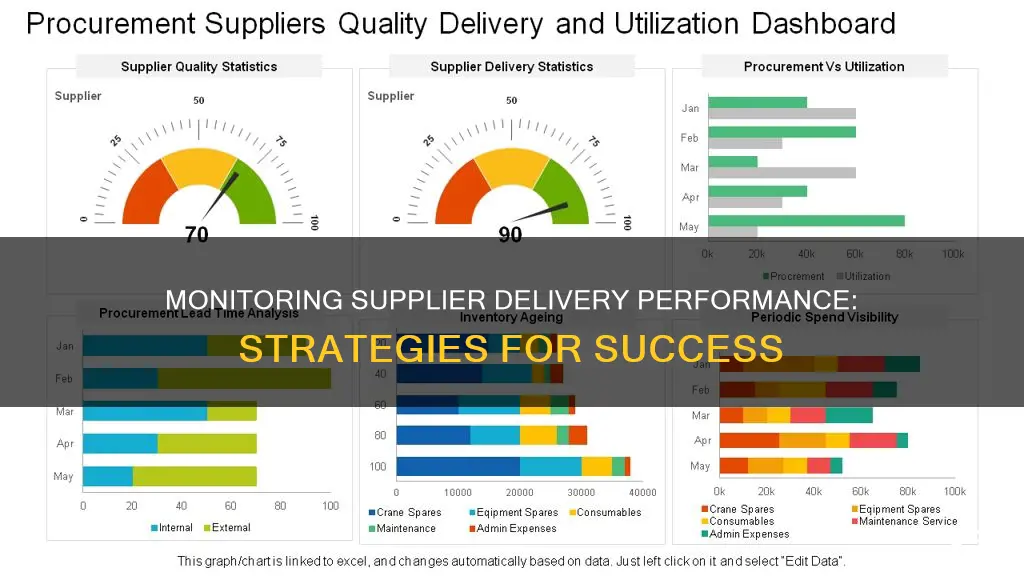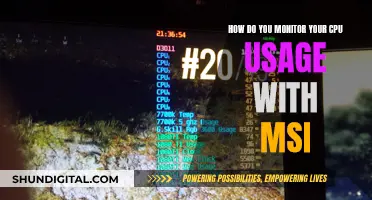
Monitoring supplier delivery performance is a critical aspect of maintaining quality, affordability, and timely supplies. Businesses need to assess the quality, cost, and delivery performance of suppliers to make informed decisions about their supply chain and ensure they are getting the best value. This involves setting clear and measurable goals, defining key performance indicators (KPIs), and establishing systems for monitoring and measuring progress. One of the most important metrics for assessing supplier performance is on-time delivery (OTD), which can be calculated in several ways, including the total number of shipments delivered on time divided by the total number of shipments due.
What You'll Learn

On-time delivery
One common method to calculate on-time delivery is to divide the total number of shipments delivered on time by the total number of shipments due. Additionally, you can specify that a certain percentage of an order must be delivered for it to be considered on time. For example, you may require 90% of an order to be delivered for it to be deemed on time.
Another important metric is the Order Fill Rate, which assesses the supplier's ability to fulfil complete orders on the promised date. This metric helps identify if there are issues with partial shipments or backorders. Late Delivery Rate is another crucial metric that tracks the percentage of orders delivered after the promised date.
To improve on-time delivery performance, it is essential to set clear expectations and goals for suppliers. These goals should be realistic and achievable, considering the supplier's current capacity and capabilities. Regularly reviewing and communicating the supplier's performance is vital, ensuring that issues are addressed promptly and corrective actions are taken.
Buying CRT Monitors: A Guide to Getting Started
You may want to see also

Order accuracy
Defining Order Accuracy
Calculating Order Accuracy
To calculate order accuracy, you can use the following formula: Order Accuracy = (Total Number of Orders Filled Correctly) / (Total Number of Orders Placed). This formula allows you to quantify the percentage of orders that are accurately fulfilled by your suppliers.
Setting Clear Expectations
It is essential to set clear expectations with your suppliers regarding order accuracy. Communicate your requirements for order fulfilment, including the acceptable defect rate, the expected quantity, and any specific quality standards that must be met. This helps suppliers understand your expectations and enables them to improve their performance accordingly.
Tracking Order Accuracy
Implement a system to track and monitor order accuracy. This could involve utilising a supplier scorecard, which records the details of each order, such as the quantity, quality, and timeliness of delivery. By maintaining a comprehensive record of order fulfilment, you can identify any discrepancies or issues that arise and address them promptly.
Comparing Ordered vs. Received Quantities
Pay close attention to the quantities ordered from your procurement department and compare them with the quantities received from the supplier. For example, if you ordered 100 units but received only 70 functional units, your order fulfilment rate would be 70%. Regularly conducting such comparisons helps identify any discrepancies in order accuracy.
Advanced Shipment Notification (ASN) Accuracy
If your suppliers provide advanced shipment notifications, it is crucial to assess the accuracy of the provided data. Compare the advanced shipment notification with the actual quantities dispatched or ordered. Evaluating ASN accuracy ensures that you receive accurate information about upcoming deliveries and can plan your operations accordingly.
Continuous Improvement
Encourage continuous improvement in order accuracy by setting achievable goals and providing constructive feedback to your suppliers. Recognise and reward suppliers who consistently achieve high order accuracy, and work collaboratively with those who need improvement. Regularly review and analyse order accuracy data to identify trends and make informed decisions.
Removing Aimpoint from Your ASUS Monitor: A Step-by-Step Guide
You may want to see also

Supplier scorecards
Scorecards are a key tool for vendor management, enabling organisations to maximise return on investment (ROI) and minimise risk. They allow businesses to communicate expectations, ensure buyers and vendors are working towards the same goals, and identify any gaps or supply chain risks.
The data gathered from a supplier scorecard is used to report vendor value, measure procurement KPIs, and monitor overall supply chain health. Executives and strategic sourcing and procurement managers are the primary administrators and users of the scorecard. However, stakeholders from other areas of the business may also contribute, such as department heads.
The construction of a supplier scorecard should be simple and versatile, allowing for performance comparisons across multiple categories. It should include at least three categories: quality, delivery, and service. Within each category, limit your evaluation template to three measurable items to keep the process straightforward.
- On-time delivery: Are they consistently on schedule?
- Quality: Do their products or services meet your standards and requirements?
- Cost: Are they within budget? Are they offering cost-reduction ideas?
- Customer service: How responsive and helpful are they?
- Compliance: Are they adhering to regulatory requirements and ethical sourcing practices?
Remember, supplier scorecards are only as reliable as the data entered into them. Ensure regular and accurate data entry to get the most out of this tool.
Best Monitor Size for Call of Duty Experience
You may want to see also

Delivery performance
To do this effectively, it is important to first define what "on-time delivery" means for your business. This could be receiving an order on the same day that the supplier promises to deliver it, or you could allow a certain number of days before or after the promised date for the order to still be considered on time. For example, you could allow two late days and two early days. If you promise delivery on 3/15, the order is not late unless it arrives after 3/17 and not early unless it arrives before 3/13. You can also specify the percentage of an order that must be delivered for it to be considered "on time". For example, you may require 90% of an order to be delivered for it to be considered on time.
Once you have defined what on-time delivery means for your business, you can begin to measure your supplier's performance. A common way to do this is to use a balanced scorecard approach, which considers both quantitative and qualitative data points. This could include the on-time delivery (OTD) rate, which measures the percentage of orders delivered on or before the promised date, and the late delivery rate, which tracks the percentage of orders delivered after the promised date. You can also measure the lead time variance, which is the difference between the promised and actual delivery dates. This helps to gauge the consistency of deliveries.
In addition to measuring on-time delivery, it is also important to track the number of orders that are delivered in full and without defects. This is known as the Delivery in Full (DIF) rate or the Order Fulfillment Rate. This metric evaluates the quantity ordered against the quantity received. For example, if you ordered 100 computers but only received 70 functional units, your order fulfillment rate would be 70%.
By tracking these metrics, businesses can identify areas where suppliers are falling short of their delivery commitments and take action to improve performance.
Monitoring Undo Tablespace Usage in Oracle: A Comprehensive Guide
You may want to see also

Supplier responsiveness
Research shows that 40% of all purchase orders will change at some point, and most of these changes are managed through spreadsheets, emails, and phone calls. When suppliers are slow to respond to these changes, it introduces risk into the supply chain. Therefore, it is important to identify, review, and modify these changes, and make them transparent to other team members.
One way to improve supplier responsiveness is to require a 100% acknowledgment rate from suppliers within a certain timeframe, such as 24 to 72 hours. This ensures that suppliers are pushed to recognize purchase orders and reduces the likelihood of job sheets getting lost in emails. Additionally, implementing a supplier rating system or using supplier management software can help improve supplier performance, including responsiveness.
It is also important to clarify what on-time delivery means to both buyers and sellers. For example, a complicated order may have multiple deliveries arriving on different dates, so it is important to determine whether the arrival of the first shipment positively impacts the on-time delivery metric or expectation. By clarifying their on-time delivery priorities and metrics, buyers and sellers can ensure a successful buyer-vendor relationship.
Monitoring GPU Usage: A Comprehensive Guide to Tracking Performance
You may want to see also
Frequently asked questions
On-time delivery (OTD) is the most important metric for assessing supplier delivery performance. It is the percentage of orders delivered on or before the promised date.
OTD is calculated by dividing the total number of shipments delivered on time by the total number of shipments due.
A supplier scorecard is a document that tracks and monitors supplier performance. It includes the supplier's name, the date of their last performance review, and their current performance rating.
Other KPIs for suppliers include customer service, product quality, cost, and lead time performance.
A consistently high level of on-time delivery, such as 90%, helps to keep inventory low, machines running, and customers happy.







